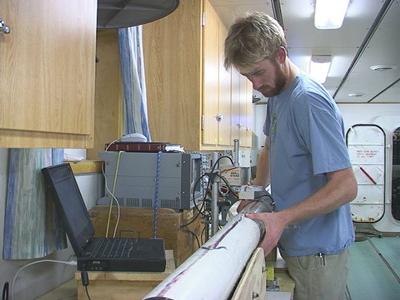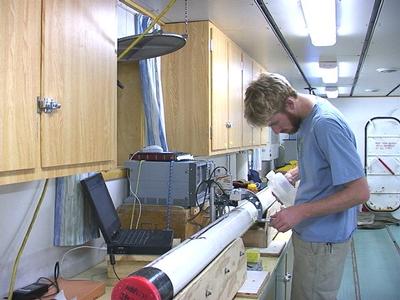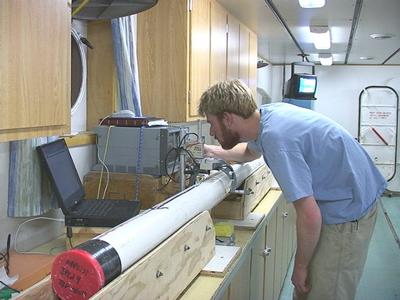
|
11 March, 2001-066 51 Latitude 069 37 S Longitude Matt Hommeyer Throughout the cruise I have mentioned several students who are here working with their professors. In the next few weeks I will try to give them an opportunity to share their work in their own words. Feel free to write them through the web site........ Hey folks, I'm a student at Middlebury College in Vermont, where I'm majoring in geology. I've made 22 trips around the sun, most of them while living in Rhode Island, so I suppose I qualify as a real live New Englander. If you'd like any more detail than that, I keep a modest web page at school http://www.middlebury.edu/~hommeyer. Highlights include climbing photos from all over the US and a recipe for making your own lava lamp. I'm here in Antarctica working on my undergraduate thesis. The true specifics remain elusive, but, in some form or another, it will consider the location and characterization of submarine glacial grounding zones. One of our best tools for sampling the sediment from these areas is the jumbo piston core [JPC]. The JPC has eight sections, each of which is about ten feet long. So if there's enough soft sediment where we want to core, we can extract up to eighty feet of mud from the bottom of the ocean. The instrument I'm using in the picture is called a P-wave logger. For every ten foot section of the JPC, it's my job to measure how fast sound travels through the sediment at two inch intervals. This is accomplished by sending a compressional sound wave across the diameter of the tube and then recording how long it takes for that sound wave to get through the mud, usually somewhere between 0.0005 and 0.0008 seconds. Since my reflexes aren't quite good enough to do that with a stopwatch, I use an oscilloscope instead. The oscilloscope shows me what the sound wave looks like so I can pick the beginning of it and get a precise value for time. Then I just measure how wide the pipe is and divide that distance by the time and I've got the velocity of sound in that parcticular two inch slice of mud.
Contact the TEA in the field at . If you cannot connect through your browser, copy the TEA's e-mail address in the "To:" line of your favorite e-mail package. |






